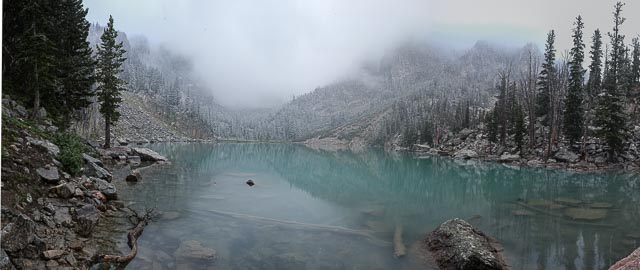In my last post I wrote about the challenges and joys of climbing Mt. Moran in Grand Teton National Park. Fortunately, climbing is not the only way to enjoy this magnificent park. Reasonably fit hikers can reach many interesting and scenic destinations in a day or less. In this post I'll detail three options -- Delta Lake, Lake of the Crags, and Static Peak -- that I have visited in the last month.
Delta Lake (8 miles roundtrip, 2,370 feet elevation gain)
Start this hike at Lupine Meadows trailhead and follow the trail towards Amphitheater Lake. You may well see wildlife along the way, like this elk.
At the first switchback after the junction to Garnet Canyon, turn off onto an unofficial and unmaintained but clear path on the right. You are now in Glacier Gulch and will need to be more careful since the route has some steep and meandering sections and crosses a boulder field.Begin this hike at the west shore dock of Jenny Lake -- you can take the boat across (for a fee) or hike around from the Jenny Lake parking area -- and head north, going towards String Lake. In about a quarter mile, look for a well worn, but unmarked, trail on the left. This unofficial and unmaintained trail up Hanging Canyon climbs more steeply than official park trails so you may want to have hiking poles, especially for the descent. As you're walking look up for close-up views of the Cathedral Group,
and down for a great view of Jenny Lake.
Towards the top you will need to navigate across a small boulder field adjacent to Arrowhead Pool, then scramble up a short, rocky defile which will bring you out near Ramshead Lake.
Continue along the path on the north side of Ramshead and then climb up the boulder field to reach Lake of the Crags.
Surrounded by steep cliffs on three sides, it is a stunning place. On warm days you may enjoy a refreshing swim, or just lounge at the edge of the lake and take in the spectacular views.
Start this hike at Whitegrass trailhead, accessed from the Moose-Wilson Road. Be prepared for rough going -- enormous potholes and large rocks abound -- on the last mile of road to the trailhead. Follow the Death Canyon trail for 3.7 miles, hiking up and over a moraine and passing the Phelps Lake overlook, to a patrol cabin.






























